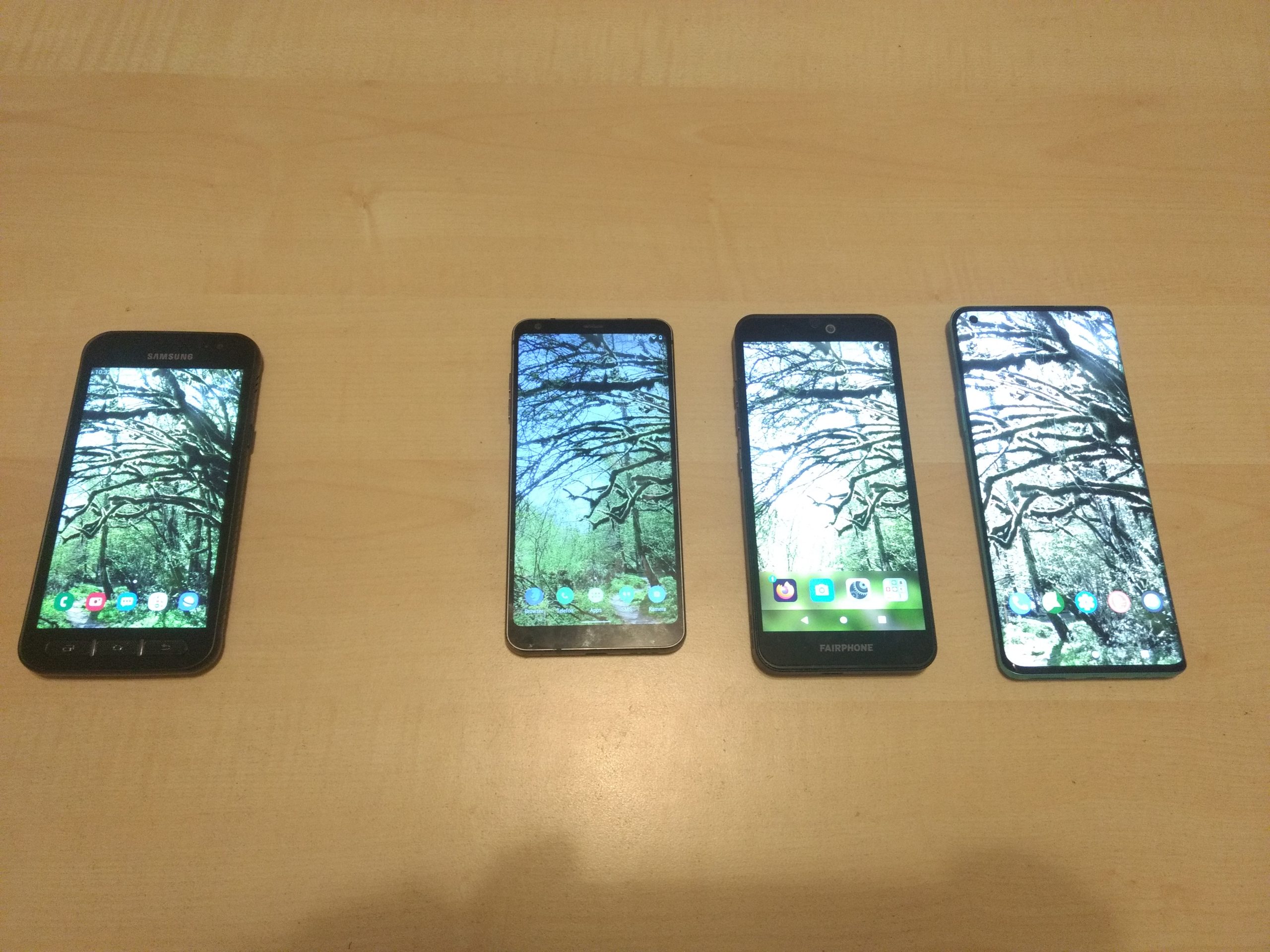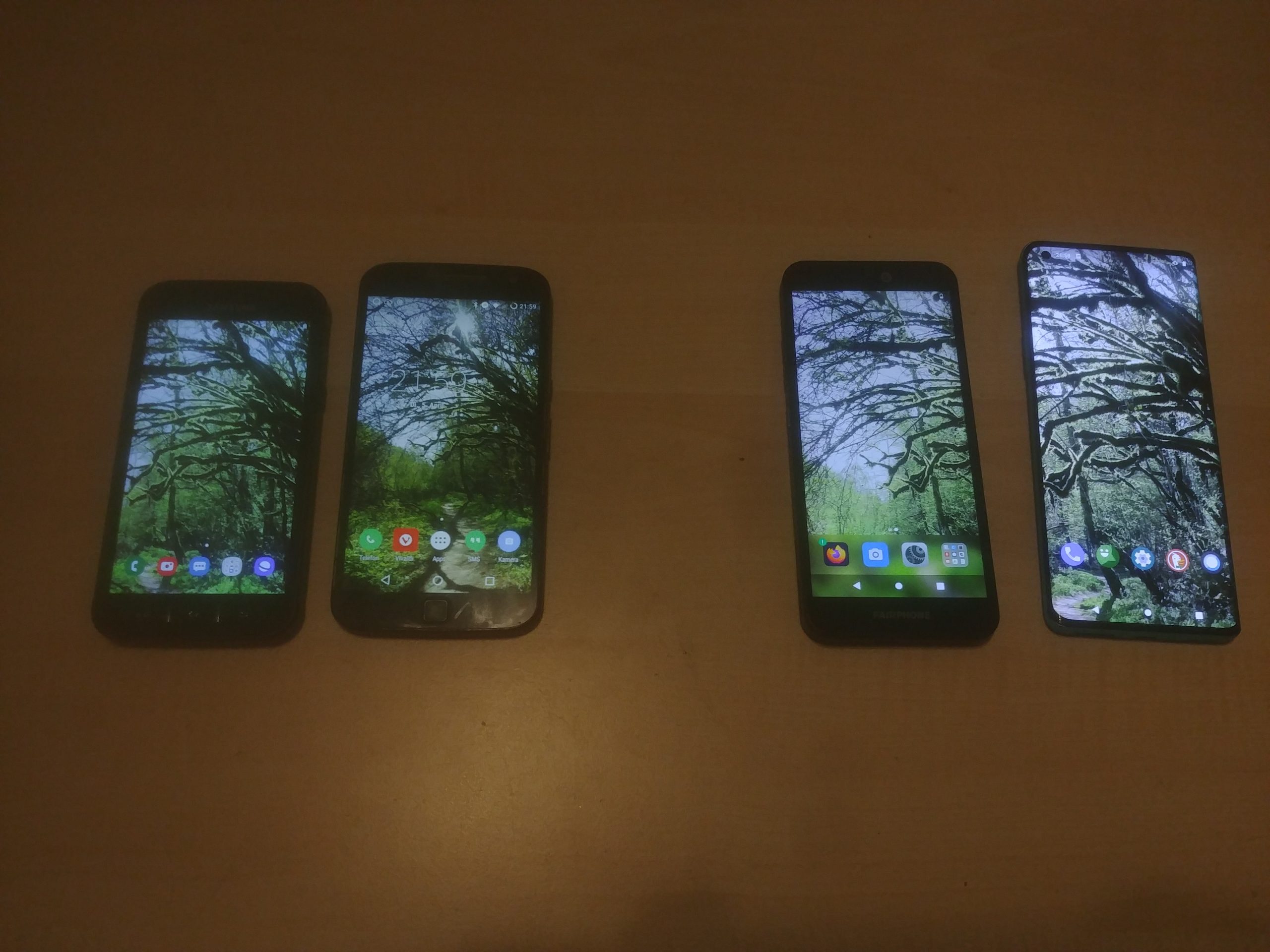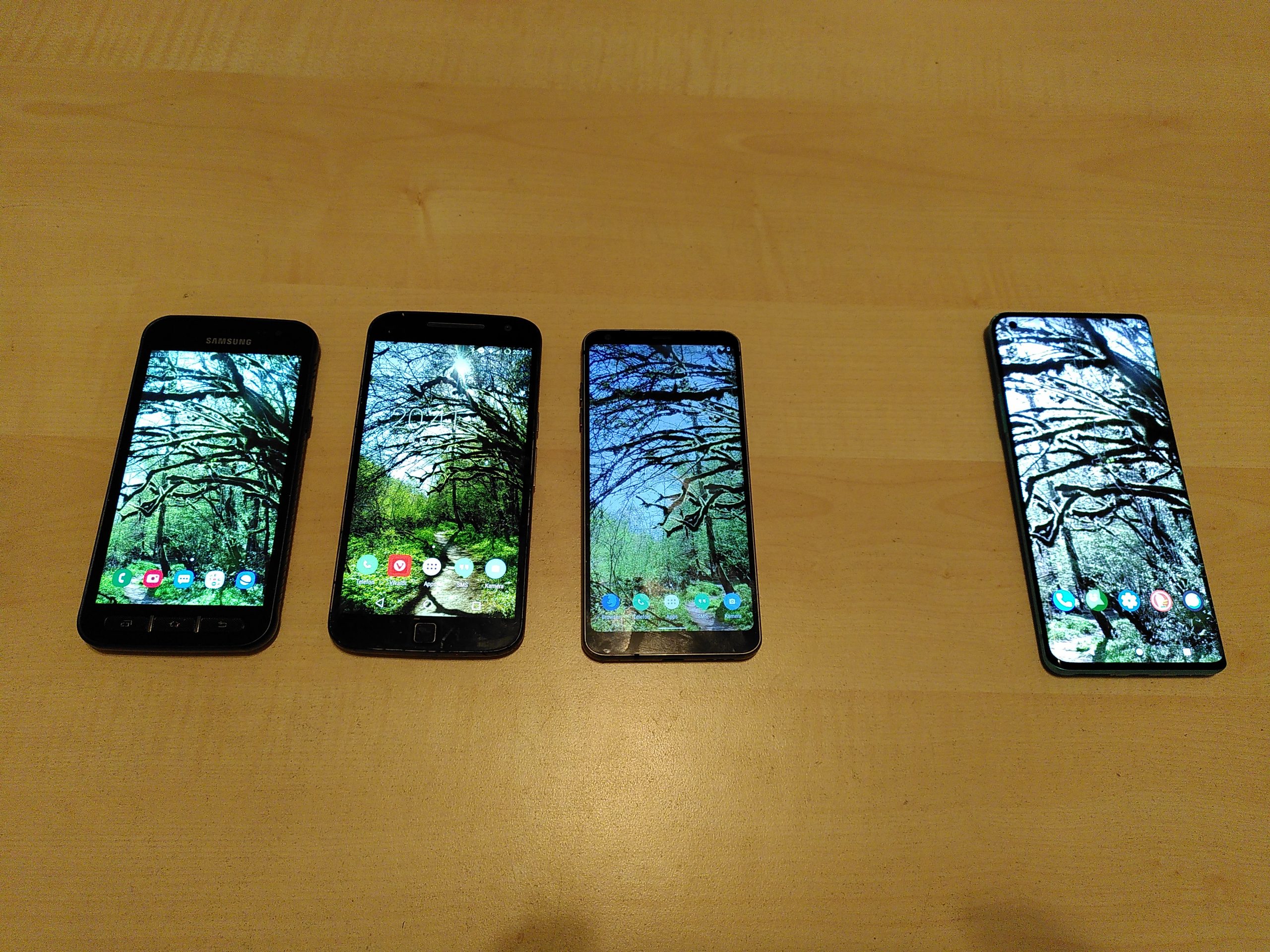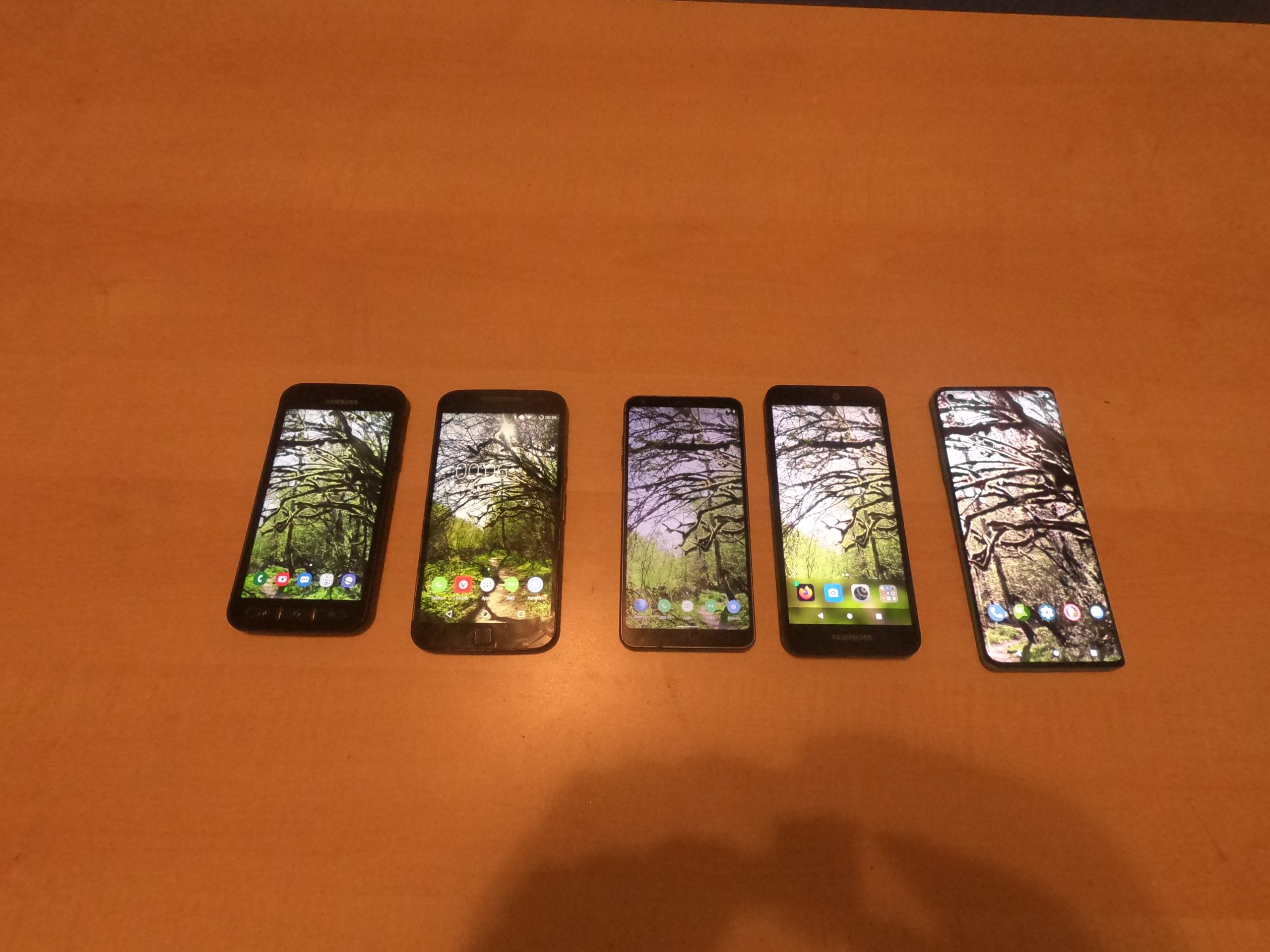5 years with “open source” smartphones
Egg, April 5, 2022: Archivista GmbH has been using open-source smartphones based on Android for almost five years. Reason enough to update the “fleet” and at the same time to venture a retrospective as well as an outlook. Instead of a complex description, which would probably scare off or overwhelm most technically inexperienced readers, the following text is kept in such a way that the devices in use are presented without too much technical stuff over the period of the last few years. First, however, a brief introduction to the current situation.
Disabled services, LineageOS or e.foundation ?
If you want to run an Android that is as open source as possible in 2022, you should (this is the recommendation at this point) go for e.foundation whenever possible. Why? Simply because Google services are not even installed (see MicroG). However, this is only possible if the desired device is also supported there. Unfortunately, the situation has rather worsened in this respect in 2022. The list of devices that can be equipped with an alternative Android is and remains very manageable.
If you do not already make sure to buy the right device when buying it, you will never be able to install an “open-source Android” in most cases. Ultimately, only those smartphones can be used that can be “unlocked”. This process is absolutely necessary to be able to install an alternative system at all. And unfortunately, more manufacturers prefer to actively prevent such an option in 2022 than to passively allow it for those who are even willing to give up all support claims for it.
However, even if the device is listed at e.foundation, this does not automatically mean that it runs perfectly. This is because an open source alternative to Android is not an easy task. The perfect combination of the sources with the firmware of the manufacturers is complex. Each device has to be tested individually. No one can do this process alone, so even smaller teams (e.g. LineageOS) cannot support thousands of devices.
But even if a smartphone is listed, this does not automatically mean that it will run satisfactorily. In many cases, the only option left in the end is therefore to deactivate Google services. This process is basically always available, but it had to be noticed, for example, in the OnePlus Pro 8 that so many messages popped up after deactivating the services that this way also seems to be a difficult one. Ultimately, this article is about installing alternative open-source versions, and therefore it was not clarified to what extent it would be possible to get by with disabled services plus/minus.
The following five devices do not claim to be a conclusive assessment. However, it is possible to show where and why problems can occur and whether or how they can be solved.
Moto G4 Plus (2016)

Image quality Moto G4 Plus: From left to right: Samsung XCover 4, LG G6, Fairphone 3+, OnePlus 8 Pro.
For the Moto G4 Plus, there is good support from e.foundation until today. Unfortunately, this cannot be observed with LineageOS; there has been no support there since 2018. Nothing can be exposed about the device’s price of approximately 250 francs. The 1920×1080 display offers an ideal resolution for watching movies in FullHD. The Moto G4 Plus is absolutely not waterproof. A device was “lost” in 2017 because it “got” water (although carried in the jacket pocket).
It is a pity that the hardware is 64-bit, but the software of the Moto G4 Plus still runs in 32-bit. Thus, all 64-bit apps do not run on the device. To make matters worse, this is not even remotely visible during the app installation process. At the end, a meaningless message ‘App installation failed’ appears. For more information, see the interesting article at xda-developers.com.
Unfortunately, only devices up to the Moto G7 Plus are supported with custom ROMs in almost all open android devices. And this is despite the fact that the bootloader and firmware are also available for newer devices. On February 21, 2022, xda-developers reports that there is an image for LineageOS 19.0 for the Moto G100.
Assessment: Although open source versions of Android could be realized for almost all devices from Motorola, in practice the selection of supported devices is massively limited after 2017. Purchase tip Motorola 2022: No.
Samsung XCover 4 (2017)

Samsung XCover 4 as the photographer: From the left, Moto G4 Plus, LG G6, Fairphone 3+, and OnePlus 8 Pro.
The device was purchased at the time because it has IP68 and a removable battery. A manual was found in some forum, according to which LineageOS could be installed on it. It has remained that way until today (with emphasis on today). There are always hints that it is possible, but there is no “nice” manual so far.
The display and the camera are “archaic”. 1280×720 for the display (even AVMultiPhone V2 offers more with 1440×720), which is from the distant past. The camera offers 13 MP and FullHD for videos. Compared with the Moto G4 Plus, the pictures are rather poor. The official updates are still available. However, as with the Moto G4, 64-bit apps are not supported.
The Samsung XCover 4 was never used as a phone, but it always proved itself in tough outdoor activities. The operation in heavy rain is difficult for pure touchscreen devices. The additional three buttons at the lower edge of the XCover 4 were and are worth their weight in gold. More than once, the device flew straight upright out of the bike mount onto the road. In the dumbest case, the smartphone, cover and battery had to be picked up individually. The plastic cover for the volume control was hit the last time and could not be found. The device nevertheless continues to work blithely.
Verdict: A good outdoor smartphone that has since found a few new variants. Stable in use, but open source is still missing. Buying tip XCover series 2022: As a navigator yes, as a smartphone no.
LG G6 (2017)

LG G6 would offer more quality in the camera, but OpenCamera does not provide more in the default setting on the HavocOS, again from left to right: Moto G4 Plus, Samsung XCover 4, Fairphone 3+, OnePlus 8 Pro. If you play with OpenCamera a bit, you can take quite good pictures with LG’s G6, even in low light.
The LG G6 was compared with the IPhone X here at the end of 2017 (German). The LG G6 was chosen because it was one of the few phones that could be equipped with LineageOS and was/is IP68 “certified”. The LG G6 did not have to hide behind the IPhone X in terms of technical data. However, LG withdrew from the smartphone business shortly after, so the LG G6, or rather the users, got the short end of the stick, no question.
Waterproof was/is the LG G6, but the operation in heavy rain is sometimes not quite easy, whereas this should be the case for all waterproof smartphones that do not have additional buttons for operation (à la Samsung XCover 4). However, one device was damaged on the back during a bike tour north in 2019 because it did not survive ten days of “sweat drops” undamaged. The device still runs, but it is no longer waterproof.
Unfortunately, LineageOS support was discontinued in 2018, but a more or less worthy successor was found in Havoc OS. In terms of software, all apps (especially those with 64-bit) still run on it. Consequently, the device is still in use today. The LG G6 can still be ordered (used or new), but it is currently difficult(er) to get it in Switzerland.
Verdict: Too bad LG has withdrawn from the smartphone market. Buying tip: Rather not, although there is still a considerable number of new and used LG G6s on marketplaces.
Fairphone 3+ (2020)

Fairphone 3+ with acceptable quality, from left to right: Moto G4 Plus, Samsung XCover 4, LG G6 as well as OnePlus 8 Pro.
Originally, the price was rather high compared to the key data. Of course, it is more than welcome when devices are manufactured as “fairly” as possible. However, it is almost impossible to verify how fairly a smartphone is produced. Even the founders admitted years ago that the Fairphone would not be produced 100% fairly, it would rather be produced more fairly.
Perhaps the Fairphone 3+ is fairer in the sense that it is modular. A display that breaks can be replaced independently, a suitable screwdriver is included. A quick look in the various stores reveals that the display can currently be ordered. Spare parts can even be ordered in Switzerland. According to the Fairphone store in the Netherlands, however, it is currently not available there.
It is and remains a balancing act. At best, spare parts are ordered at the time of purchase, or later, when it is needed, there is the risk that the required components are not available. With the Fairphone+, there is at least the chance that the components of used devices can be recycled individually. This should make the Fairphone 3+ a lot fairer than devices where the whole device has to be thrown away in case of a defective part.
The camera of the Fairphone 3+ offers more than enough with 48 MP. The pictures are quite convincing in practical use. Videos in 4K with 30 frames/second are possible. However, the results of both the installed Android and the e.foundation version are not completely satisfactory. And this is independent of whether Full HD or 4K is used for filming. The recordings quickly look distorted; an old GoPro offers better quality.
On the other hand, the Fairphone 3+ can be ordered from e.foundation, so there is no need to install it yourself. If you want to buy the Fairphone 3+ in Switzerland, you can easily get the images from the e.foundation server. There is even a graphical installer for Windows and Linux. Under Linux, however, the snap-based installer did not work for AVMultimedia. However, the classic approach via the command line was so well described that there was no need to dig out Windows.
Assessment: Great up-to-date device at a fair price, support for e.foundation very good. The Fairphone 4 would be an even more modern device, but it lacks the SD card slot, so the Fairphone 3+ would currently be the right choice. The only drawback is that hobby filmmakers and Instagram queens will probably not enjoy the device as much. Buy tip: Those who can do without IP68 and high-quality videos will find an ideal device in the spirit of open source. Regarding protection against water and dust, there are providers of corresponding packaging bags. This was not tested, but a trial is planned for the near future.
OnePlus 8 Pro (2020)

OnePlus 8 Pro offers good quality even with LineageOS, from left to right: Moto G4 Plus, Samsung XCover 4, LG G6 as well as Fairphone 3+.
Those who want to run an IP68-certified smartphone with open source will still face a search for a needle in a haystack in 2022. Strictly speaking, the haystack is a heap, because as mentioned at the beginning, the list of supported devices is rather small anyway.
If you check the list at e.foundation or LineageOS, you will quickly find out that OnePlus devices up to and including OnePlus 9 Pro are currently supported. The devices from OnePlus are very well available in Switzerland. The price of the 8-series version in the Pro version is plus/minus 600 francs. For this price, you get a smartphone that does not have to shy away from comparisons with the flagships from Apple or Samsung.
The OnePlus 8 Pro already has an optical 3x zoom (even the IPhone 13 Pro Max does not offer more). It also works flawlessly with the installed Android. Magnifications up to a factor of 10 work well in photos. However, anyone who has held an optical zoom-capable video camera in their hands will find zooming on a OnePlus 8 Pro to be a nice gadget, but nothing more. However, the camera itself is convincing in both photos and movies in 4K (with/without exposure optimization [HDR]).
According to the homepage e.foundation, the OnePlus 8 Pro is listed as having a beta for it. The installation is much more strenuous than with the Fairphone 3+. The device boots in the end, but the OnePlus 8 Pro cannot be operated stably with e.foundation with the best will in the world. Neither Wi-Fi nor the connection to the mobile network succeeded, and the device froze after a few minutes.
It is hard to say what the reason is. There were some hints on the web that it would have been advisable to first perform all update steps with the installed Android, since the firmware would also be updated. Now, all Androids always have two operating systems. One is the system and the other is a slimmed-down emergency system (recovery).
And that is what happened, which could always be avoided in the past five years. When trying to reload the original Android system, both versions were somehow irrevocably destroyed. The device could no longer be booted at all. The return bill at the retailer had already been filled out when the tip could be found in a forum that the OnePlus 8 Pro had a “rescue system” even in this case.
By pressing the Volume+Plus as well as the Volume-Minus key simultaneously for about 1 minute (that is a damn long time), it could be reset to a Super Recovery mode, which succeeds in uploading new versions. And indeed, with the finger cramp exercise at deep night hours, the OnePlus 8 Pro could be given a new lease of life.
The installation of the original system still failed afterwards, but LineageOS managed to boot the smartphone normally. And since then, it runs to full satisfaction. The camera lacks the “button” for the 3x optical zoom, but movies with 4K and 30 frames/second succeed in very good quality. The stabilization, e.g. when running on a dirt road, is convincing, and even the ambitious hobby filmmakers or Instagram kings (if they exist) will be thrilled.
And something else should be mentioned at this point. With all previous smartphones, it was first necessary to type in some specific firmware information on an external homepage to unlock the boot sector before alternative systems could be installed. This is not only inconvenient, but also annoying for a long time if the manufacturer decides to disable the corresponding homepage. If the boot sector is still not unlocked, the device can be thrown away. Fortunately, this was not the case with the OnePlus Pro 8. Unlocking the boot sector requires a few clicks, nothing more. That is how it should be.
Assessment: The OnePlus 8 Pro is not easy to install. However, once installed, the device surpasses all other smartphones presented here by perceived worlds. Those who find the Pro series too big (6.7 inches is not nothing) should go for the “ordinary” device, even though the water and dust protection is not granted there. The 10-series version has just been unveiled. Unfortunately, the OnePlus 10 Pro no longer has an IP68 rating, which massively restricts outdoor use. Buying tip: The OnePlus 8 Pro offers a lot for comparatively little money. A price of around 600 Swiss francs (12 GB RAM, 256 GB storage, camera with 48 MP) corresponds to a good price-performance ratio. A corresponding Samsung or Apple device costs twice as much. Tip: Do all system updates on the original Android before installing LineageOS. The detour via Volume+Plus and Volume+Minus with a one-minute press works, but they were even hectic moments, definitely not recommended.

A comparison with a relatively old GoPro 7P shows that even a mini camera that is several years old does not have to hide. It should be added that the GoPro’s video stabilization will probably outshine much more expensive smartphones even in 2022. A GoPro 8 does not cost 300 Swiss francs, the combination with a Fairphone 3+ offers “the fiddly bits”, and the additional weight of about 130 grams for the action cam is not worth mentioning.
Conclusion in 2022: Situation remains unsatisfactory
What remains after five years of experience with smartphones based on Android that are as open source as possible? Not necessarily what would be desired. The search giant exploits the market power quite elegantly by linking Android with Google services in such a way that it is almost impossible to work without them. Although the corresponding apps can be deactivated, deactivated is not uninstalled. As long as there is a button for activation, the software is also basically available.
Incidentally, the company’s currently moth-eaten approach, analogous to Apple, to make it mandatory for any options in a purchased app to run via PlayStore, shows that they are trying to cement a market power that is not only arbitrary, but downright immoral when measured against the performance (processing the payment as such) of 30 percent. If e.g. a photo library with 100 pictures costs 100 kneads, then 30 Thaler already represent there an unreasonable approach. If the library contained however 1000 pictures and cost 500 kneads, then 150 Thaler go thereby directly into the pocket of the giants, and this for the same simple transaction. Justified from the costs would be probably approx. 0.x to 1.x per cent.
The top dogs always counter that they would also offer publicity. No, with a market power like e.g. with Youtube one cannot speak of a promotion, rather the companies impose such arbitrary rules that decide 100% whether something is still perceived. Let’s just hope that one day some antitrust authority will ensure that the market can play again.
A good approach would be to prohibit manufacturers from “nailing down” the devices so that no alternative operating system can be installed. That way, millions (billions over the years) of devices would not have to be disposed of every year just because there is no support for them anymore. The alternative for more sustainable devices would otherwise be for manufacturers to be obligated to offer a minimum of 5 years of support for a product, for example.
However, those who only use a smartphone occasionally will probably be able to work with a device for much longer than that. For companies, such an obligation would also be a much bigger cut than the fact that the owner of the device still benefits from the warranty if the customer relationship no longer exists.
Unfortunately, it is currently almost impossible for non-professionals to even install an alternative open operating system to Android. The Fairphone 3+ and e.foundation are a commendable exception. The combination can currently also be highly recommended, but it corresponds to fractions of per thousand of the sold devices in the best case.
Compared with 2017, things look a bit better when it comes to installing apps. Thanks to Aurora Store, apps can also be obtained from the Play Store without requiring an account. The purchase via fdroid.org is recommended. All apps that are available under an open source license can be found there. Most of the time, there are also helpful notes, in case of the Aurora Store: The app promotes non-open source network services.
That is true, of course, but 100% open source (also for the apps) is almost impossible with an open-source Android-based smartphone, then rather an AVMultiPhone. But if you do online banking in Switzerland (which everyone was “forced” to do), there is no alternative, because all banking apps are closed source (silent, as the industry is).
At least, both the OnePlus 8 Pro and the Fairphone 3+ have alternative stores. It should be noted that the providers are probably well aware of the software giant’s market power. Nevertheless, and precisely because of that, the situation remains unsatisfactory. Conclusion in one sentence: If you want to have an alternative open Android in 2022, you can at least buy it from e.foundation. In this sense, it is a ray of hope on a distant horizon.
After note: If you only need a smartphone for what it was “invented” for, i.e. making calls and texting, the PinePhone currently (whether with PostmarketOS Phosh or AVMultiPhone V2) is a recommendable alternative. Great photos and videos can also be achieved with an action cam. This has not least to do with the design. The little things are discreet, so that far more spontaneous recordings are possible, because they are not conspicuous. A smartphone with 6 inches or more looks a lot bigger.


